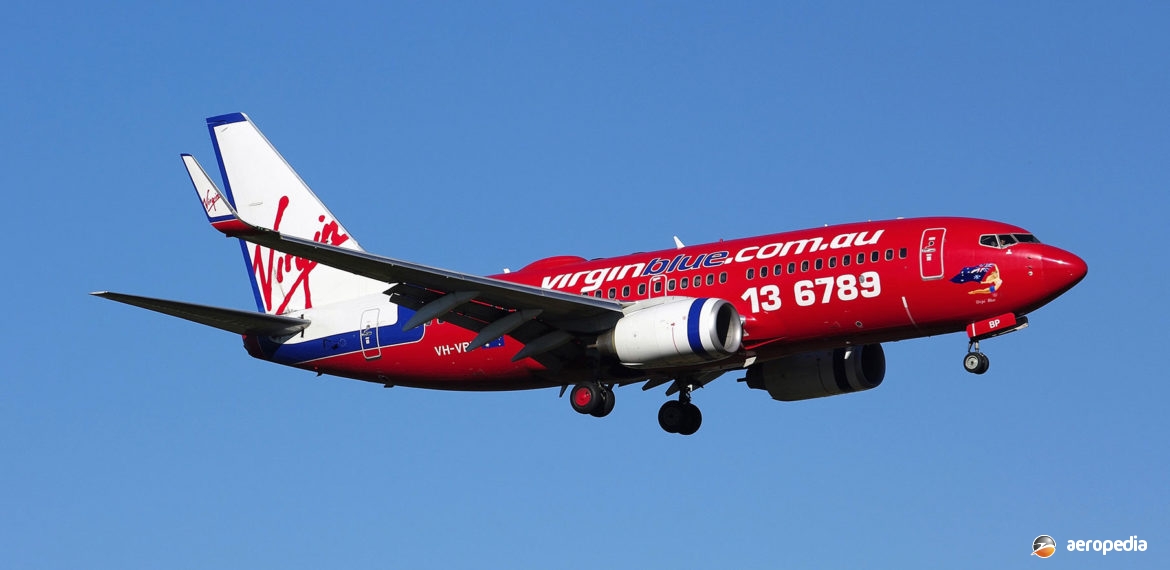Photograph:
Boeing 737-7BX VH-VBP (c/n 30743) of Virgin Airlines at Mascot, NSW in July 2008 (David C Eyre)
Country of origin:
United States of America
Description:
Short to medium range commercial airliner
Power Plant:
Two 22,000 lbst General Electric CFM56-7B turbofans
Specifications:
- Wingspan: 34.31 m (112 ft 7 in)
- Length: 33.63 m (109 ft 4 in)
- Height: 12.58 m (41 ft 3 in)
- Wing area: 125 m² (1,344 sq ft)
- Typical cruising speed Mach: 0.785
- Max certificated altitude: 12,497 m (41,000 ft)
- Range with 128 passengers: 2,935 km (1,824 miles)
- Empty weight: 38,006 kg (83,790 lb)
- Loaded weight: 60,320 kg (133,000 lb)
History:
Following the success of the first generation series 737s Boeing developed further models, the 737-600, 737-700, 737-800 and 737-900, the 737-600 and 737-700 being the smaller aircraft in the new series and featuring more efficient CFM56-7 turbofans, this engine combining the core of the CFM56-5 engine with the low pressure compressor of the CFM56-3 and a 1.55 m (61 in) fan. A new wing was developed of greater chord, span and wing area, and the tail surfaces were enlarged.
The Next Generation aircraft, as it was known, was launched in November 1993. The Models 737-800 and 737-900 introduced new fuselage lengths, seating for 189 in lieu of 100 in the original Model 737-100, and a Boeing 777 type EFIS flight-deck with six flat panel LCDs was installed.
Next models in the series were the 737-600 and 737-700. The Model 737-600 had seating for 108 passengers in two classes, and the 737-700 had seating for 128 in two classes. These newer generation aircraft had more efficient CFM56-7 turbofans of 20,000 lbst in the 737-600 and 22,000 lbst in the 737-700, these engines providing these models with a higher cruising speed and greater range.
The first Model 737-600 flew on 22 January 1998, and the first Model 737-700 on 7 December 1996. The higher take-off weight variant of the Model 737-700 had 24,000 lbst CFM56-7B engines and an increase in max take-off weight to 70,080 kg (154,500 lb). The first of the latter Model 737-700 flew on 9 February 1997 at Renton in Washington State, being delivered to Southwest Airlines, entering service on 18 January 1998.
Boeing also developed the Boeing Business Jet (BBJ). Based on the Model 737-700, this was a joint venture between Boeing and General Electric to market a corporate variant of the 737 series airliner, and the first of this type aircraft flew on 4 September 1998 and continued in production for some time. In later times winglets were developed to enhance performance. The 737 series has been a major success for the Boeing company. More than 10,000 have been built, and production has continued.
The Boeing 737 has been and is still used in large numbers in this region, operators including Virgin Blue in Australia, Pacific Blue, Qantas, and Qantas subsidiary Jetconnect, which commenced services on domestic routes in New Zealand in 2002 using Model 737-33As. By mid 2006 Virgin had a fleet of 50 Boeing 737s, most being 737-700 and 737-800 series.
The Model 737-700 series was supplied to the US Navy in some numbers. One 737-700 series (a 737-7X2) was operated by Air Pacific in this region DQ-FJF (c/n 28878) and was fitted with CFM56-7 engines.
Virgin Blue Airlines, later Virgin Airlines, was the largest operator of the 737-700 series in this region, and at the end of 2007 its fleet of Model 737-7Q8s included: VH-VBA (c/n 28238), VH-VBB (c/n 28240), VH-VBC (c/n 30638), VH-VBD (c/n 30707), VH-VBF (c/n 30630), VH-VBH (c/n 30641), VH-VBI (c/n 30644), VH-VBJ (c/n 30647), VH-VBK (c/n 30648), VH-VBL (c/n 30633). The fleet of Model 737-76Ns included: VH-VBM (c/n 327340, VH-VBN (c/n 33005), VH-VBO (c/n 33418); Model 737-7BX VH-VBP (c/n 30743), VH-VBQ (c/n 30744), VH-VBR (c/n 30745), VH-VBS (c/n 30746), and VH-VBT (c/n 30740); Model 737-76Q VH-VBU (c/n 30288); Model 737-7BK VH-VBV (c/n 33015); Model 737-7FE VH-VBY (c/n 34323) and VH-VBZ (c/n 34322). The latter aircraft seated 144 and when delivered was named ‘Maliblue., being repainted in 2015 and becoming ‘Cronulla Beach’.

